All this recent talk of codes and ciphers has made
me think of messages of all sorts. One of the earliest references to writing
comes in Homer’s Iliad, which is somewhat ironic in that the Iliad comes
from the time of pre-literate Greece. Homer, the individual poet, almost
certainly did not exist and the epics attributed to him are made up from the
works of a number of different poets, collected together over time and
performed under the name of Homer.
 |
| Homer |
These poems were memorised and recited on
special occasions and celebrations by professional bards, they are the product
of an oral tradition that existed before the invention of writing. And yet, in
this orally transmitted poem, there is a single mention of writing. It comes
in Book VI, and is contained in a story within a story concerning Bellerophon,
a prince lusted over by Anteia, wife of King Proteus. When Bellerophon rejects
her advances, Anteia tells her husband that the youth had tried to ravish her.
 |
| Bellerophon |
Greek hospitality excluded Proteus from directly harming Bellerophon, his guest
and thus under his protection, so Proteus
“gave him tokens, murderous signs, scratched in a folded tablet,”
and sent him to Iobates, Anteia’s father.
The tablets held a message telling Iobates of the supposed crimes committed by
their bearer against his daughter, with instructions that the youth should be
slain, (the same restrictions on harming a guest made Iobates send Bellerophon
on a series of seemingly impossible quests, in the hope that he would be
killed, but that’s a story for another day).
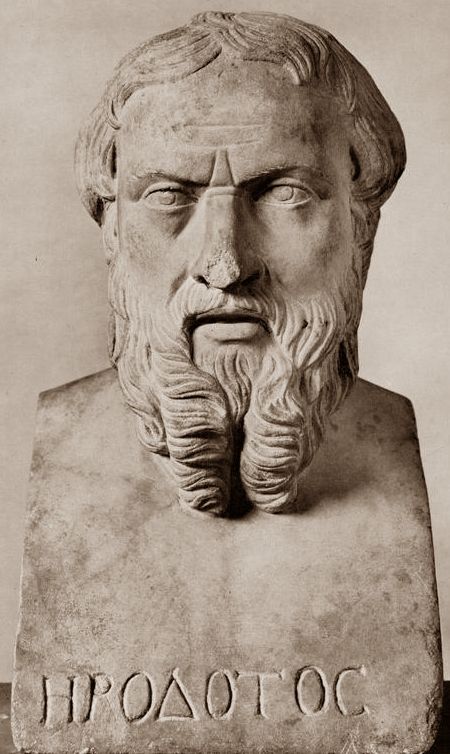 |
| Herodotus |
Turning now to another Greek
source, in his Histories Herodotus tells how Histiaeus, a puppet tyrant
of Miletus under the Persian King Darius the Great, was unhappy with being held
in Susa, Darius’s capital, and contrived to send a message to Aristogoras, his
nephew and son-in-law, who held temporary rule of Miletus, urging him to start
a revolt in Ionia. Histiaeus’s method was ingenious to say the least – he
shaved the head of his most trusted slave, tattooed his message on his scalp
and waited until the man’s hair had regrown. When suitably hirsute, the slave
was sent to Aristogoras, with no other information than that his head should be
shaved, thus revealing the message. (An Ionian revolt began in 499 BCE, which
was crushed by the Persians after six years of warfare, leading directly to the
later Persian invasions of Greece and, again, that’s a tale for another time).
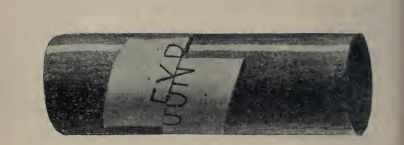 |
| Scytale |
Another Greek method of sending a concealed message, one particularly favoured
by the Spartans, was the scytale, which was a wooden baton with a strip
of leather or parchment wrapped around it. The message was written on the
parchment and sent to the recipient, who wrapped the strip around an
identically sized baton of his own. It is simple and easy enough to be used to
send short messages in the heat of battle, and complicated enough to confound
an enemy, for at least a short while, if it should happen to be intercepted.
Archilochus, a poet from the seventh century BCE, mentions ‘a grievous
scytale’ and the dramatist Aristophanes
uses the phrase σκυτάλα Λακωνκα (‘the Laconian skytale’) in his
play Lysistrata (441 BCE) but the first description does not occur until
Plutarch’s Life of Lysander (late first century CE),
“These pieces of wood were called scytale. When they had any secret and important orders to convey to him, they took a long narrow scroll of parchment, and rolled it about their own staff, one fold close to another, and then wrote their business on it.”
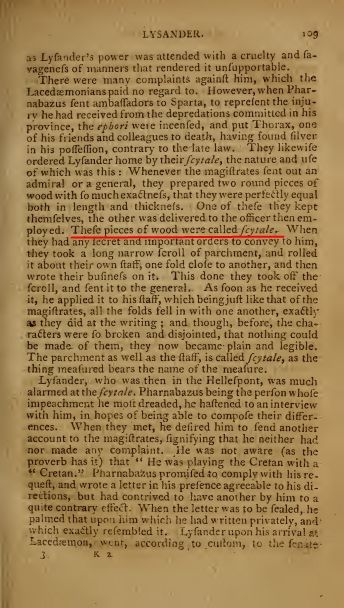 |
| Plutarch - Life of Lysander |
In Roman times, we know from Suetonius’s Lives of
the Twelve Caesars, that Julius Caesar and Augustus used substitution
ciphers to send secret messages,
“If he had anything confidential to say, he wrote it in cipher, that is, by so changing the order of the letters of the alphabet, that not a word could be made out. If any one wishes to decipher these, and get at their meaning, he must substitute the fourth letter of the alphabet, namely D, for A, and so with the others.”
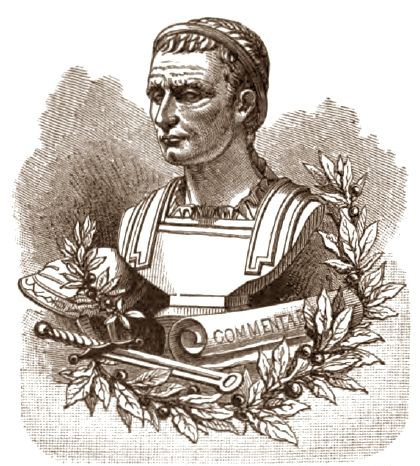 |
| Julius Caesar |
Taking this idea one
step further, symbols can be substituted for the letters of the alphabet, either
directly or after the message has already been alphabetically shifted.
Let’s
try a straightforward one-thing-for-another code. Take this message,
§ £43i 45 2 + 9 +§51 4= 8732+ 287 45 2 + 9 £&=+
It looks difficult, but if we
apply some simple rules, it’s quite easy to crack. The first symbol ‘§’ stands
alone, so it’s likely to be either ‘A’ or ‘I’. The ‘2+9’ is a three-letter word
and it appears twice in the message, so let’s make a leap that it stands for ‘the’.
Even from this small beginning, our message now reads,
A £43i 45 the ha51 4= 8732h t87 45 the £&=h *
I’ll leave you to work the rest of it out, but
here’s a clue –it’s a proverb. Any sort of symbol can be substituted for the
letters in a message – maybe the most familiar example in the Sherlock Holmes
story ‘The Adventure of the Dancing Men,’ where stick figures are left
chalked about the property of Mr Hilton Cubitt, (and I’ll leave you to read
that for yourself).
 |
| The Dancing Men |
Another sort of cipher is shown by this example. During the
English Civil War, the royalist Sir John Trevanion was captured and imprisoned
in Colchester castle, awaiting execution. He received the following
communication from a friend,
“WORTHIE SIR JOHN—Hope, that is ye beste comfort of ye afiflictyd, cannot much, I fear me, help you now. That I wolde saye to you, is this only : if ever I may be able to requite that I do owe you, stand not upon asking of me. 'Tis not much I can do : but what I can do, bee you verie sure I wille. I knowe that, if dethe comes, if ordinary men fear it, it frights not you, accounting it for a high honour, to have such a rewarde of your loyalty. Pray yet that you may be spared this soe bitter, cup. I fear not that you will grudge any sufiferings : only if bie submission you can turn them away,'tis the part of a wise man. Tell me, an if you can, to do for you any thinge that you wolde have done. The general goes back on Wednesday. Restinge your servant to command.”
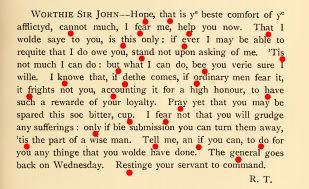 |
| Secret Message to Sir John Trevanion |
Left alone in his cell, Sir John reads the secret
message in this seemingly innocent communiqué. By taking the third letter after
every comma or full stop, he reads PANELATEASTENDOFCHAPELSLIDES – ‘panel at
east end of chapel slides’ – and so, when left alone to pray before he is
sent to meet his maker, Sir John slides back the panel and makes his escape. Unfortunately,
the intrepid Sir John was killed later at the siege of Bristol.
* - Just in case you haven't cracked the code, "A Bird in the Hand is Worth Two in the Bush"
No comments:
Post a Comment